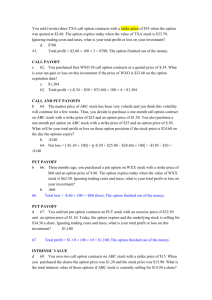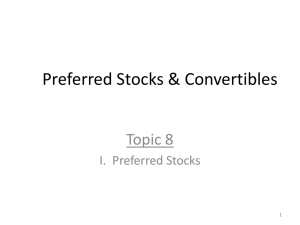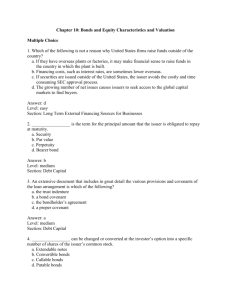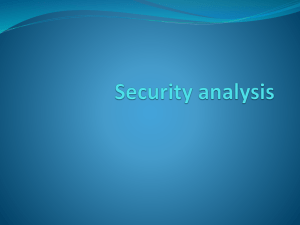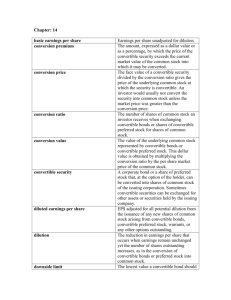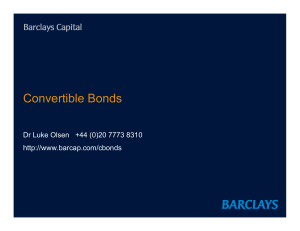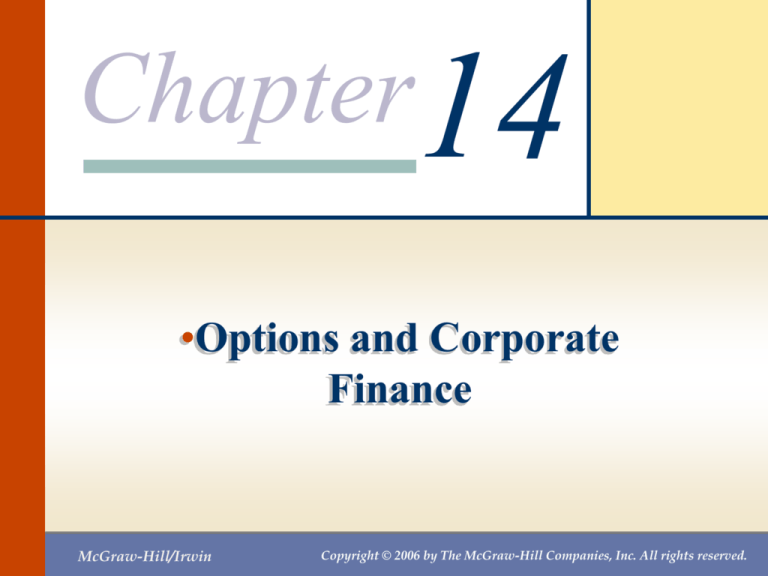
Chapter14
•Options and Corporate
Finance
McGraw-Hill/Irwin
Copyright © 2006 by The McGraw-Hill Companies, Inc. All rights reserved.
Chapter 14 – Index of Sample
Problems
•
•
•
•
•
•
•
•
Slide # 02 - 06
Slide # 07 - 12
Slide # 13 - 16
Slide # 17 - 23
Slide # 24 - 29
Slide # 30 - 34
Slide # 35 - 41
Slide # 42 - 48
Put option
Call option
Call expiration value
Current value of call option
Equity as a call option
Option to wait
Option to abandon
Convertible bonds
Options
• Right to buy or sell underlying at preagreed
price (exercise price, strike) at prearrange
time
• Call: buy
• Put : sell
• American
• European
2: Put option
You currently own 1,000 shares of BPR, Inc. stock. You would like
to have the option to sell these shares for $35 each anytime
between now and July.
What type of option order might you place in this situation?
3: Put option
You currently own 1,000 shares of BPR, Inc. stock. You would
like to have the option to sell these shares for $35 each
anytime between now and July.
Do you want to be the party that determines if the option is
exercised?
Do you want to buy or sell shares of stock?
How many shares of stock do you want to trade?
What price are you looking for?
4: Put option
Do you want to be the party that determines if the option is
exercised?
Answer:
Yes
Effect:
You must be the buyer of the option contract.
Do you want to buy or sell shares of stock?
Answer:
Sell
Effect:
You need to buy a put option.
5: Put option
How many shares of stock do you want to trade?
Answer:
1,000
Effect:
You need 10 contracts.
What price are you looking for?
Answer:
$35
Effect:
You need an exercise price of $35.
6: Put option
How long do you want to have this option in effect?
Answer:
Until July
Effect:
You need July contracts.
Can you put it all together to describe the option contract that fits
your situation?
Answer:
Yes!
Effect:
You need to buy 10 July 35 put options.
7: Call option
Expiration
Month
Strike
Price
Call
Price
Apr
25
.50
May
25
.80
Jun
25
1.15
You want to buy May call options on 500 shares of stock. How much
will you have to pay to acquire these options? Ignore commission
costs.
8: Call option
Expiration
Date
Strike
Price
Call
Price
Per
Share
May
25
.80
You want to buy May call
options on 500 shares of stock.
How much will you have to pay
to acquire these options?
Total cost = 500 .80
= $400
9: Call option
Expiration
Date
Strike
Price
Call
Price
Apr
25
.50
May
25
.80
Jun
25
1.15
This morning, you purchased a June call option contract at the price
shown. Assume that you immediately exercise this contract. How
much will you spend in total to acquire each share of stock, ignoring
commissions?
10: Call option
This morning, you purchased a
June call option contract at the
price shown. Assume that you
immediately exercise this
contract. How much will you
spend in total to acquire each
share of stock?
Expiration
Date
Strike
Price
Call
Price
Jun
25
1.15
Total cost per share = $1.15 + $25.00
=$26.15
(ignoring commissions and trading costs)
Strike or not strike
• E: exercise price, S: stock cisrprice
• Call: S<E : expire : payoff=0
S>E : exercise : payoff=S-E
Put: S<E: expire : payoff=E-S
S>E : exercise : payoff=0
11: Call option
Last week, you purchased six call option contracts with a strike
price of $20 and an option price of $3. Today, the stock is selling
for $28 a share.
How much total profit will you make if you exercise your options
today and then sell your shares of stock?
12: Call option
Last week, you purchased six call option contracts with a strike
price of $20 and an option price of $3. Today, the stock is selling
for $28 a share. How much total profit will you make if you exercise
your options today and then sell your shares of stock?
Total profit = 6 100 ($28 - $3 - $20)
= 600 $5
= $3,000
(ignoring commissions and trading costs)
13: Call expiration value
You own a call option on ABC stock. The call has an exercise price
of $35.
What is the value of this option at expiration if ABC stock is selling
for $34 a share at that time?
14: Call expiration value
You own a call option on ABC stock. The call has an exercise price
of $35. What is the value of this option at expiration if ABC stock is
selling for $34 a share at that time?
C1=0 if S1 E
This says that the call is worthless on the expiration date when the
stock price is less than the exercise price, which it would be in this
case.
15: Call expiration value
You own a call option on XYZ stock. The call has a strike price of
$20.
What is the value of this option at expiration if XYZ stock is selling
for $22 a share at that time?
16: Call expiration value
You own a call option on XYZ stock. The call has a strike price
of $20. What is the value of this option at expiration if XYZ
stock is selling for $22 a share at that time?
C1 = S1 - E if S1 E
C1=$22 - $20
= $2
This says that the option price on the expiration date is equal
to the stock price minus the exercise price whenever the
stock price is greater than the exercise price.
Current Value (Simple model part I:
in-the-money)
•
•
•
•
C0: current call value, S0=current stock price,
E: exercise price, Rf= interest rate
S0=C0+E/(1=Rf)
C0=S0-E/(1+Rf)
17: Current value of call option
Assume that you own a call option that expires in one year. The
exercise price of the call is $60. The risk-free rate is 4%. The
current price of the stock is $87. Assume that the option will expire
in the money.
What is the current value of the call option?
18: Current value of call option
Assume that you own a call
option that expires in one
year. The exercise price of
the call is $60. The risk-free
rate is 4%. The current price
of the stock is $87. Assume
that the option will expire in
the money. What is the
current value of the call
option?
E
C 0 S0
1 Rf
$60
$87
1 .04
$87 $57.69
$29.31
19: Current value of call option
(simple model part II: out-of-themoney)
KNF stock is currently selling for $30 a share. The stock price is
expected to be either $32 or $38 a share one year from now. The
risk-free rate is 10%. You own a stock option on KNJ with an
exercise price of $35.
What is the value of one option today?
20: Current value of call option
The KNF stock is currently selling for $30 a share. The stock price
is expected to be either $32 or $38 a share one year from now. The
risk-free rate is 10%. You own a stock option on KNJ with an
exercise price of $35. What is the value of one option today?
$32
PV R f
1 .10
$29.09
You invest $29.09 today in a risk-free asset.
This asset will be worth $32 in one year.
The risk-free asset will be equal in value to the lowest expected
stock price one year from now.
21: Current value of call option
S
Number of options needed
C
$38 $32
$3 $0
$6
$3
2 options
22: Current value of call option
$32
$30 (2 C0 )
1 .10
$30 (2 C0 ) $29.09
$.91 2 C0
C0 $.455
23: Current value of call option
If the stock price is $32, then:
Risk-free asset = $32
Options
=$ 0
Total position = $32
($32 is less than the exercise price of $35.)
If the stock price is $38, then:
Risk-free asset = $32
Options
=$ 6
Total position = $38
($38 - $35 = $3; $3 2 = $6)
Employee Stock Options (ESO)
• Vesting
• Forfeiture
• Repricing
24: Equity as a call option
The assets of the Limelite Co. are currently worth $1,050. These
assets are expected to be worth either $900 or $1,200 one year
from now. The company has a pure discount bond outstanding
with a $1,000 face value. The bond matures in one year. The riskfree rate is 8%.
What is the value of the equity in this firm?
What is the value of the debt?
25: Equity as a call option
Step 1.
Invest the present value of the lower asset value
in one year at the risk-free rate of return.
$900
Investment in risk - free asset
1 .08
$833.33
26: Equity as a call option
Step 2.
Determine the value of the equity in the firm one
year from now assuming that the assets are worth
the higher of the two possible amounts
Value of equity high $1,200 $1,000
$200
27: Equity as a call option
Step 3.
Determine the number of options needed
S
Number of options needed
C
$1,200 $900
$200 $0
$300
$200
1.5
28: Equity as a call option
Step 4.
Determine the option value, which is the value of
the equity
$1,050 (1.5 C0 ) $833.33
$216.67 1.5C0
C0 $144.45
29: Equity as a call option
Step 5.
Determine value of the debt
Value of debt $1,050 - $144.45
$905.55
30: Option to wait
Jasper and Company are considering a new project which has an
initial cost of $600. If they wait one year, the project cost will rise to
$625. If they start the project today, it will produce cash inflows of
$300 a year for three years. If they wait one year to start the project,
it will produce cash inflows of $350 a year for three years. The
discount rate for this project is 10%.
What is the value of the option to wait?
31: Option to wait
What is the net present value of the project if they start it today?
What is the net present value of the project if they wait and start it
one year from now?
What is the value of the option to wait?
32: Option to wait
What is the net present value of the project if they start
it today?
$300
$300
$300
NPV $600
1
2
(1 .10) (1 .10) (1 .10)3
$600 $272.727 $247.934 $225.394
$146.055
$146.06 (rounded )
33: Option to wait
What is the net present value of the project if they wait and start it
one year from today?
$350
$350
$350
NPVt 1 $625
1
2
(1 .10) (1 .10)
(1 .10)3
$625 $318.182 $289.256 $262.960
$245.398
$245.398
1.10
$223.089
NPVt 0
$223.09
34: Option to wait
What is the value of the option to wait?
Value of option to wait $223.09 - $146.06
$77.03
35: Option to abandon
You are considering a project with an initial cost of $220,000. You
expect to sell 3,000 units a year for 5 years. The net cash flow per
unit is $20. The rate of return is 10%.
What is the base case net present value of this project?
36: Option to abandon
You are considering a project with an initial cost of $220,000. You
expect to sell 3,000 units a year for 5 years. The net cash flow per
unit is $20. The rate of return is 10%. What is the base case net
present value of this project?
1 [1 /(1 .10)5 ]
NPV $220,000 [(3,000 $20)
.10
$220,000 $60,000 3.7907868
$220,000 $227,447.21
$7,447.21
37: Option to abandon
You are considering a project with an initial cost of $220,000.
You expect to sell 3,000 units a year for 5 years. The net
cash flow per unit is $20. The rate of return is 10%.
Now assume that you can abandon this project after two
years at which time the project can be sold for $110,000.
At what level of sales would you be willing to abandon this
project?
38: Option to abandon
You are considering a project with an initial cost of $220,000. You
expect to sell 3,000 units a year for 5 years. The net cash flow per
unit is $20. The rate of return is 10%. Now assume that you can
abandon this project after two years at which time the project can
be sold for $110,000. At what level of sales would you be willing
to abandon this project?
1 [1 /(1 .10)3 ]
$110,000 (Q $20)
.10
$110,000 $20Q 2.486852
$110,000 $49.73704Q
Q 2,211.63 units
39: Option to abandon
You are considering a project with an initial cost of $220,000. You
expect to sell 3,000 units a year for 5 years. The net cash flow per
unit is $20. The rate of return is 10%. Now assume that you can
abandon this project after two years at which time the project can
be sold for $110,000.
Suppose now that you expect sales to be either 2,000 units or
4,000 units per year starting in year three of the project. You place
50/50 odds on these estimates.
What is the net present value of this project given these new
assumptions?
40: Option to abandon
If the sales quantity is 2,000 units, you will abandon the project and
receive $110,000.
If the sales quantity is 4,000 units, you will continue the project.
The project will have a net present value of $198,948.16 at that time.
1 [1 /(1 .10)3 ]
NPV (4,000 $20)
.10
$80,000 2.486852
$198,948.16
41: Option to abandon
$110,000 $198,948.16
3,000 $20 3,000 $20
2
NPV $220,000
1
2
(1 .10)
(1 .10)
(1 .10) 2
$60,000 $60,000 $154,474.08
$220,000
1
2
1.10
1.10
1.10 2
$220,000 $54,545.455 $49,586.777 $127,664.529
$11,796.761
$11,796.76 (rounded)
42: Convertible bonds
A bond with a $1,000 face value can be converted into 40 shares of
common stock.
What is the conversion price?
43: Convertible bonds
A bond with a $1,000 face value can be converted into 40
shares of common stock. What is the conversion price?
$1,000
Conversion price
40
$25
44: Convertible bonds
Suzette owns 500 convertible bonds. These bonds have a face
value of $1,000, a 6% coupon and a maturity date of 10 years. The
bonds are convertible into shares of common stock at a
conversion price of $36.525.
How many shares of stock will Suzette receive if she converts all of
her bonds?
45: Convertible bonds
Suzette owns 500 convertible bonds. These bonds have a face value
of $1,000, a 6% coupon and a maturity date of 10 years. The bonds
are convertible into shares of common stock at a conversion price of
$36.525. How many shares of stock will Suzette receive if she
converts all of her bonds?
$1,000
Number of shares 500
$36.525
500 27.3785
13,689.25 shares
46: Convertible bonds
Mary owns a convertible bond that matures in 8 years. The
bond has a face value of $1,000, a 6% coupon and pays
interest semi-annually. The conversion price is $42.16. The
current price of the stock is $43.03. The market return on
similar bonds is 8%.
What is the straight bond value?
What is the conversion value?
47: Convertible bonds
.08 82
)
.06 $1,000
$1,000
2
Straight bond value
.08
.08 82
2
(1
)
2
2
$30 11.652296 $533.91
1 [1 /(1
$883.48
Enter
Solve for
82
N
8/2
I/Y
PV
883.48
60/2
PMT
1,000
FV
48: Convertible bonds
Mary owns a convertible bond that matures in 8 years, has a
face value of $1,000, a 6% coupon and pays interest semiannually. The conversion price is $42.16. The current price of
the stock is $43.03.
$1,000
Conversion value
$43.03
$42.16
23.719165 $43.03
$1,020.64
Chapter14
•End of Chapter 14
McGraw-Hill/Irwin
Copyright © 2006 by The McGraw-Hill Companies, Inc. All rights reserved.

